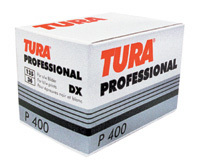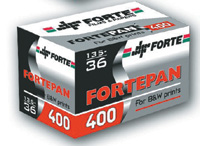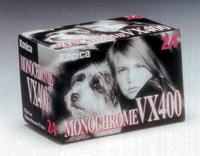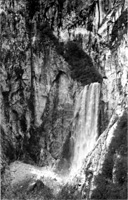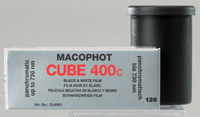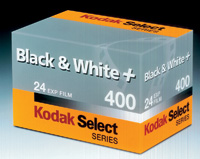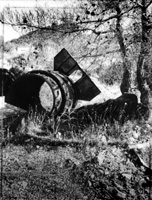ISO 400 Black And White Films
The Best Keeps On Getting Better
This article was very nearly
called "9600," which is what you get if you multiply 24
by 400. Twenty-four films, that is, times ISO 400. There are at least
this many, though half a dozen or so aren't available in the US.
Even 18 films is however a pretty impressive number for a market that
the advocates of digital keep trying to tell us is nearly dead! |
|||
Which Is Best...For
You? Old Tech |
|||
In fact, new "old technology"
films are still being introduced. The most recent of which I am aware
is Maco's Cube 400c. The "Cube" in the name gives the
title away: this is an "old technology" film, but it is amazingly
good, a fit rival to HP5 and Tri-X. It's so incomparably better
than the same manufacturer's UP 400 that it's hard to see
why the latter remains in production. |
|||
|
|||
Tonality is always the joker
in the pack, not least because it seems to involve as much alchemy as
science: a film from which one photographer extracts superb tonality may
be a disaster area for another. You can't even describe it, except
obliquely or by analogy. I loved one description of HP5 as "like
Casablanca--the movie, not the place" but my favorite came
from a senior man at Ilford: "XP2 is smooth, and HP5 is gnarly."
|
|||
Chromogenic Latitude |
|||
Inevitably, I have concentrated in this article on the two biggest players, Ilford and Kodak. But other manufacturers' films also have their merits, though I have only had space to note a couple of my favorites. Then there are low-cost films which can have a further, surprising advantage: some are very similar (read: identical) to better-known emulsions. Try some of Arista's or Tura's films, for example. Q&A--Agitation |
|||
How do these acutance
effects work? They are part of a set of phenomena called adjacency
effects. If you have a dark area against a light area, the developer is
used up faster where there is more silver to develop. Acutance developers
give a little more density on one side of the line, and a little less
on the other, for increased apparent sharpness. This relies on the developer
not being replaced too often as a result of agitation. |
|||
Are these the limits?
No. At one extreme there's constant agitation, which works
fine if you aren't looking for adjacency effects, and at the other,
you could probably agitate as little as a couple of seconds a minute--one
inversion--without running into trouble. You'd get maximum
sharpness, minimum grain, and minimum speed. |
|||
Q&A--Film Developers Why would anyone use
a "plain vanilla" general-purpose developer? Many
people reckon they give the best combination of desirable factors: reasonably
fine grain, full ISO film speed, and good sharpness. The classic "plain
vanilla" developer is Kodak's |
|||
Before we get back
to sharpness, what are acutance developers? Actually, they bring
us back to sharpness. An acutance developer is designed to enhance the
contrast between a light area and a neighboring dark area, which gives
higher sharpness. Things like bicycle spokes or park railings will be
significantly better delineated. But grain is slightly coarser than with
a "plain vanilla" developer, and there may be a speed loss--though
often, there isn't. |
|||
How long do developers
keep? A vexed question. Powdered developers should last indefinitely
in their original sealed packages, but have a life of a few months or
even a few weeks once they are mixed up. This is why some powdered developers
are mixed up to give "stock solutions" which are then further
watered down for use: the stock solution (concentrate) keeps better. Are powder developers
better, or liquid? Better for what? Powders are cheaper, for
two reasons. First, you aren't paying to have water shipped around.
Second, the manufacturers often have to use significantly more expensive
chemicals in liquid concentrates, either for solubility or to avoid hydrolysis
(breakdown of the chemicals in solution). But liquids are more convenient,
and you don't have any risk of breathing toxic dust when you mix
them. Depending on the formulation, both can give equally excellent results,
which is why so many manufacturers offer close equivalents in both forms:
Ilford offers both Microphen (powder) and Ilfotec DD-X (liquid) as speed-increasing
developers. |
|||
Other friends tell
me that films aren't really as fast as their ISO speeds. Are they
using fine-grained developers and losing speed? Possibly--or
maybe, like the ones who rate HP5 Plus at 1600 and think it's an
ISO speed, they just don't understand ISO very well. Another possibility
is that they are using the wrong metering technique. Or maybe they just
prefer negatives that have been exposed more. There's nothing wrong
with any of that: the speed you should use is the one that you like best.
But under ISO conditions, using the manufacturer's stated developer,
most films reach their ISO speed. |
|||
Manufacturers/Distributors Cachet/Fappco (Maco: UP 400;
Cube 400c) Eastman Kodak Company Freestyle Photographic Supplies
(Arista: Professional 400; D-Max 400) |
|||
Fuji Photo Film USA, Inc. (Neopan
400) Konica Minolta Photo Imaging
U.S.A., Inc. (VX-400, chromogenic) OmegaSatter (Forte: Fortepan
400) Tura USA (Professional 400;
Chromogenic) |
